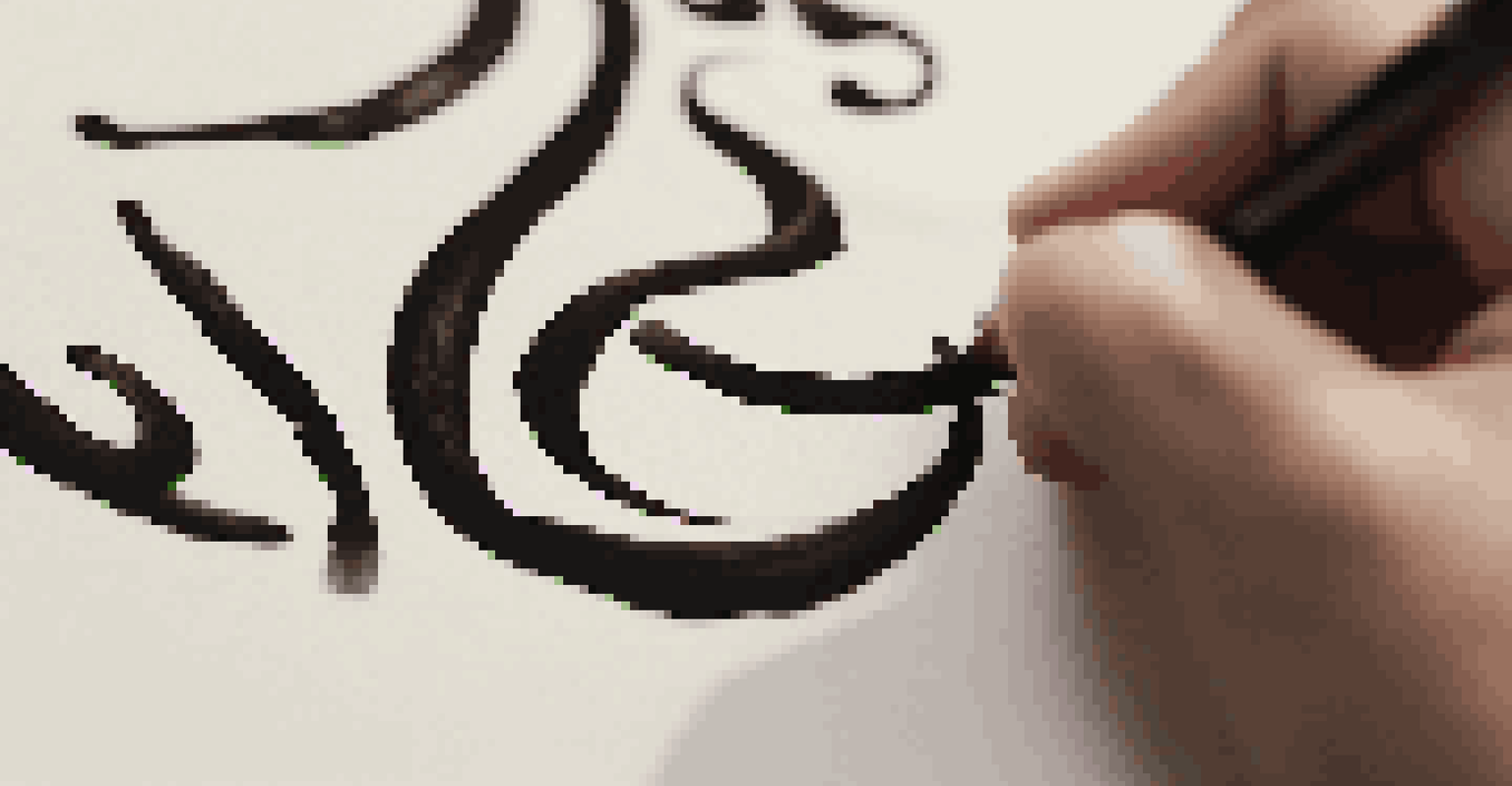The Impact of Calligraphy on Cultural Identity

Understanding Calligraphy and Its Origins
Calligraphy is more than just beautiful handwriting; it’s an art form with deep cultural roots. Originating from various regions around the world, such as East Asia and the Middle East, calligraphy reflects the intricacies of language and cultural nuances. For instance, Arabic calligraphy is not only a means of communication but also an expression of faith and tradition.
Calligraphy is a kind of music not for the ears, but for the eyes.
Different cultures have developed unique styles of calligraphy, each telling a story about their heritage. The strokes and curves in Chinese calligraphy, for example, are imbued with philosophical meaning, representing balance and harmony. As such, understanding calligraphy requires an appreciation of its historical context and the values it embodies.
Ultimately, calligraphy serves as a bridge connecting individuals to their cultural identity, making it essential to explore its origins. This art form stands as a testament to the beauty of language and the diversity of cultural expression across the globe.
Calligraphy as a Reflection of Cultural Values
At its core, calligraphy is a reflection of the values and beliefs of a culture. For instance, in many Eastern traditions, the elegance and fluidity of the script symbolize grace and harmony in life. This connection between the art of writing and cultural philosophy highlights the importance of calligraphy in shaping identity.

Moreover, the use of specific materials and techniques in calligraphy often signifies cultural significance. For example, the fine brushes and ink used in Japanese calligraphy are carefully chosen to evoke a sense of mindfulness and precision. This attention to detail emphasizes how calligraphy can embody a culture's aesthetic values.
Cultural Roots of Calligraphy
Calligraphy is an art form that reflects the deep cultural values and historical contexts of various societies.
In this way, calligraphy becomes a visual representation of what a culture holds dear, allowing individuals to connect with their heritage. Through each stroke, calligraphers express not just words, but the very essence of their cultural identity.
The Role of Calligraphy in Religious Practices
Calligraphy plays a significant role in various religious practices around the world, often serving as a medium for spiritual expression. In Islamic culture, for instance, calligraphy is used to beautifully transcribe verses from the Quran, making the sacred text accessible and visually appealing. This practice enhances the spiritual experience and deepens the connection to faith.
The pen is the tongue of the mind.
Similarly, in East Asian cultures, Buddhist texts are often rendered in calligraphic form, highlighting the importance of mindfulness and meditation. The act of writing these texts becomes a form of worship, allowing practitioners to immerse themselves in their beliefs while creating art. This intertwining of spirituality and artistry reveals the profound impact calligraphy has on cultural identity.
Thus, calligraphy transcends mere decoration; it becomes a vital part of religious life, allowing communities to express and reinforce their beliefs. This connection between calligraphy and spirituality showcases how art can embody cultural values and foster a sense of belonging.
Calligraphy in Cultural Preservation and Heritage
In an age of rapid digital communication, calligraphy serves as a vital link to cultural heritage. Many communities are actively working to preserve traditional calligraphic practices that may otherwise be lost. Workshops and classes are organized worldwide, encouraging younger generations to engage with this art form and understand its significance.
By learning the art of calligraphy, individuals not only acquire a skill but also gain insights into their cultural history. For example, mastering the intricacies of Persian calligraphy allows practitioners to appreciate centuries of artistic expression while fostering a sense of pride in their heritage. This hands-on experience strengthens cultural identity in a tangible way.
Calligraphy in Modern Design
Today, calligraphy influences modern design, blending traditional styles with contemporary aesthetics to enhance visual communication.
Moreover, preserving calligraphy also means safeguarding the stories, traditions, and languages that accompany it. Efforts to document and teach these practices ensure that future generations can connect with their cultural roots, fostering a continued appreciation for the art of writing.
The Influence of Calligraphy on Modern Design
Today, calligraphy continues to influence modern design in various fields, from branding to digital art. Designers often incorporate calligraphic elements to evoke a sense of elegance and sophistication, drawing from traditional styles to create contemporary pieces. This fusion of old and new showcases the timeless appeal of calligraphy.
For instance, many wedding invitations and event stationery feature calligraphic fonts that add a personal touch, reflecting the celebratory nature of the occasion. This trend highlights how calligraphy can enhance visual communication while maintaining cultural relevance in a modern context. By blending tradition with innovation, calligraphy remains a vital part of contemporary aesthetics.
As calligraphy adapts to modern design, it retains its cultural significance while reaching new audiences. This evolution not only keeps the art form alive but also fosters an appreciation for its rich history, reminding us of the enduring power of beautifully crafted letters.
Calligraphy as a Tool for Personal Expression
Beyond its cultural implications, calligraphy serves as a powerful tool for personal expression. Many individuals find solace and creativity in the practice of writing beautifully, allowing them to convey emotions and thoughts in a unique way. Whether it's through journaling or creating personalized gifts, calligraphy offers an outlet for self-discovery and reflection.
Moreover, the meditative nature of calligraphy can be therapeutic, helping individuals to focus and unwind. As each stroke is carefully crafted, practitioners often experience a sense of calm and mindfulness, enhancing their overall well-being. This personal connection to the art form further emphasizes its role in shaping individual identity.
Calligraphy as Personal Expression
Beyond its cultural significance, calligraphy serves as a therapeutic outlet for personal expression and creativity.
In this light, calligraphy transcends cultural boundaries, inviting anyone to engage with the art form. By embracing calligraphy, individuals can explore their creativity and forge a deeper connection with themselves, highlighting its universal appeal as a means of expression.
The Future of Calligraphy in a Digital Age
As society becomes increasingly digitized, the future of calligraphy may seem uncertain; however, it remains relevant and adaptable. Many artists are embracing technology, using digital tools to create stunning calligraphic designs that reach wider audiences. This blending of traditional techniques with modern technology ensures that calligraphy continues to thrive in contemporary culture.
Moreover, social media platforms have played a significant role in reviving interest in calligraphy. Artists share their work online, inspiring others to learn and appreciate this beautiful art form. This global community fosters a sense of connection among calligraphers, regardless of geographical boundaries, highlighting the enduring importance of cultural identity.

Ultimately, the future of calligraphy lies in its ability to evolve while retaining its core values. By embracing change and fostering creativity, calligraphy will continue to enrich cultural identity and inspire generations to come.